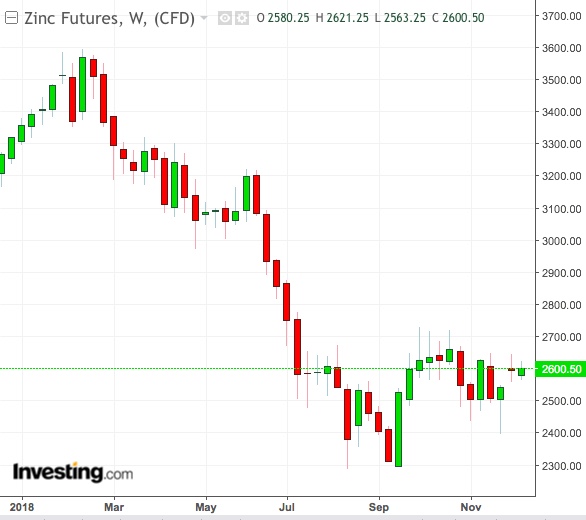The US-China trade truce has come a little too late for global metals markets, which are set for one of their worst outings ever in 2018. In a rare phenomenon, the futures of nearly every traded base metal in London and New York are set to finish the year with double-digit losses, despite top commodities buyer China halting its tariff battle with the United States amid expectations of an imminent deal between the two economic superpowers.
Zinc led base metals losses for the year with a 22 percent plunge, followed by lead (-21 percent), copper and aluminum (-15 percent), and nickel (-14 percent). The only metal with a minor loss on the year was tin, which was headed for a loss of just under 3 percent.

Notwithstanding the sea of red for metals futures, sector leaders such as copper, lead, nickel and zinc could see price recovery in 2019 if encouraging themes like the easing of the trade war and weakening of the dollar continue, analysts said.
Immense Headwinds Since Summer
Bank of America-Merrill Lynch’s metals strategists, led by Michael Widmer and Francisco Blanch, noted in their year-end outlook, published this week, that the world of mined commodities “have faced immense headwinds since summer.”
They added:
“Our business cycle model is now firmly in 'Recession', usually the most bearish phase for commodities. A move into 'Recovery' is essential, potentially facilitated by a stabilization of activity in China on the back of the recent tentative stimulus.”
That shift is, of course, unlikely in the next two weeks, although the Wall Street Journal reported on Tuesday that China could hand US President Donald Trump a symbolic, if not major, victory in the trade war by granting foreign firms access to its protected technology and manufacturing sectors.
China To Decide 2019 Policies Only From Next Week
While a Wednesday report by Reuters of strong buying of US soybeans by China—which indicated a good follow-through to the recently announced 90-day truce between Trump and Chinese leader Xi Jinping—the South China Morning Post said on Thursday that China will only decide beginning next Tuesday, regarding its major policies for 2019, including trade interactions with the United States.
This means that metals-focused Commodity Trading Advisors (CTAs), or funds that dabble in the space, could increase their bearish positions through the year-end to maximize returns from directional bets. TD Securities’ metals analysts led by Bart Melek and Ryan McKay said in another outlook published Wednesday:
“The bar is low for CTAs to significantly increase their short positioning in copper as what is left of upside momentum wanes. In fact, a break below the $6,085/ton range in the red metal would imply that systematic trend followers could increase their shorts to some 70% of their historical maximum position size.”
US Largest Copper Provider For China
Since the US-Sino trade war accelerated in July, copper prices have fallen almost every month, and for good reasons: China is the largest consumer of the metal—accounting for nearly half of global estimated demand of around 24 million tones—and the US is one of its main sources.

Copper futures in both London and New York are down about 15 percent on the year, with UK prices hovering at $6,192 a ton while US prices trade near $2.79 a pound. Investing.com’s daily technical outlook on New York copper calls for a “Buy.” The metal currently trades above its 100-Day Moving Average and the strongest sell recommendation only emerges at the 200-Day Moving Average of $2.89, meaning it had chart strength to gain about 4 percent.
BAML forecasts that London copper will average $6,667 a ton in 2019 versus $6,313 this year.
Copper has proven to have an unusually long reaction lag of 11 months to stimulus measures, meaning the impact of China’s $1.4 billion economic package announced in October could only be realized in the metal by the next fall season. Still, BAML expected copper’s supply-demand to be balanced by next year, although it noted a projected slowing of the global economy and demand in early 2019.
Assorted Price Outlooks For Metals In 2019, With Mostly Positive Bias
Despite the double digit losses for other base metals, Investing.com has a “Sell” recommendation on aluminum and nickel based on its daily technical outlook, a “Buy” on lead and a “Strong Buy” on zinc. As well, BAML analyst forecasts provide the following price outlooks:
- London-traded nickel: the 2018 average price of $13,625 a ton was expected to rise to $15,693 next year, BAML said. But in order for that to happen, stainless steel production and demand from electric vehicles had to pick up, while Indonesian output had to be controlled, it said.
- London-traded aluminum: the 2018 average of $2,025 a ton was barely expected to change next year, with a forecast average of $2,026, BAML said. Aluminum’s challenges basically revolved around no limits to Chinese production, it added.
- London-traded lead: this year’s average of $2,050 a ton was expected to rise to $2,181 in 2019, BAML said. One of the main problems facing lead was the maturing of China’s e-bike industry.
- London-traded zinc, the 2018 average of $2,313 a ton was forecast to rise to $2,347, BAML said. It noted that zinc had been the outperformer of the base metal complex in 2016, and the resultant rally had pushed up the supply of zinc concentrates sharply in the last two years—a glut that now had to be cleared.
